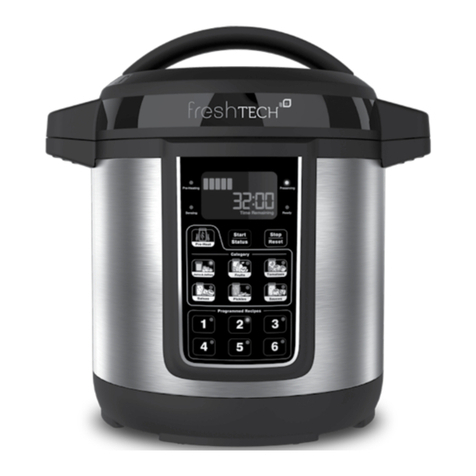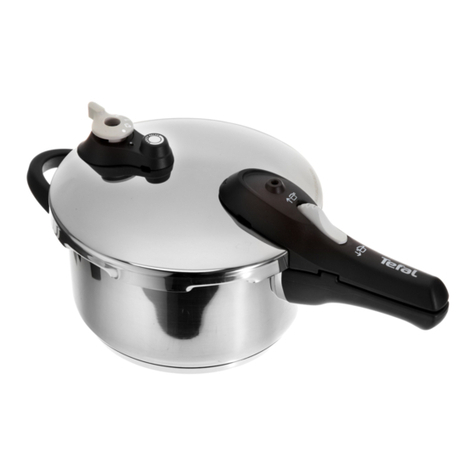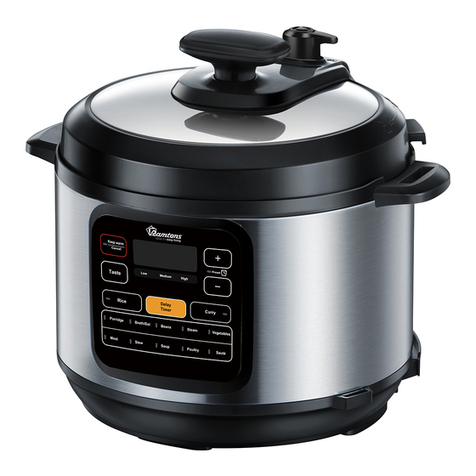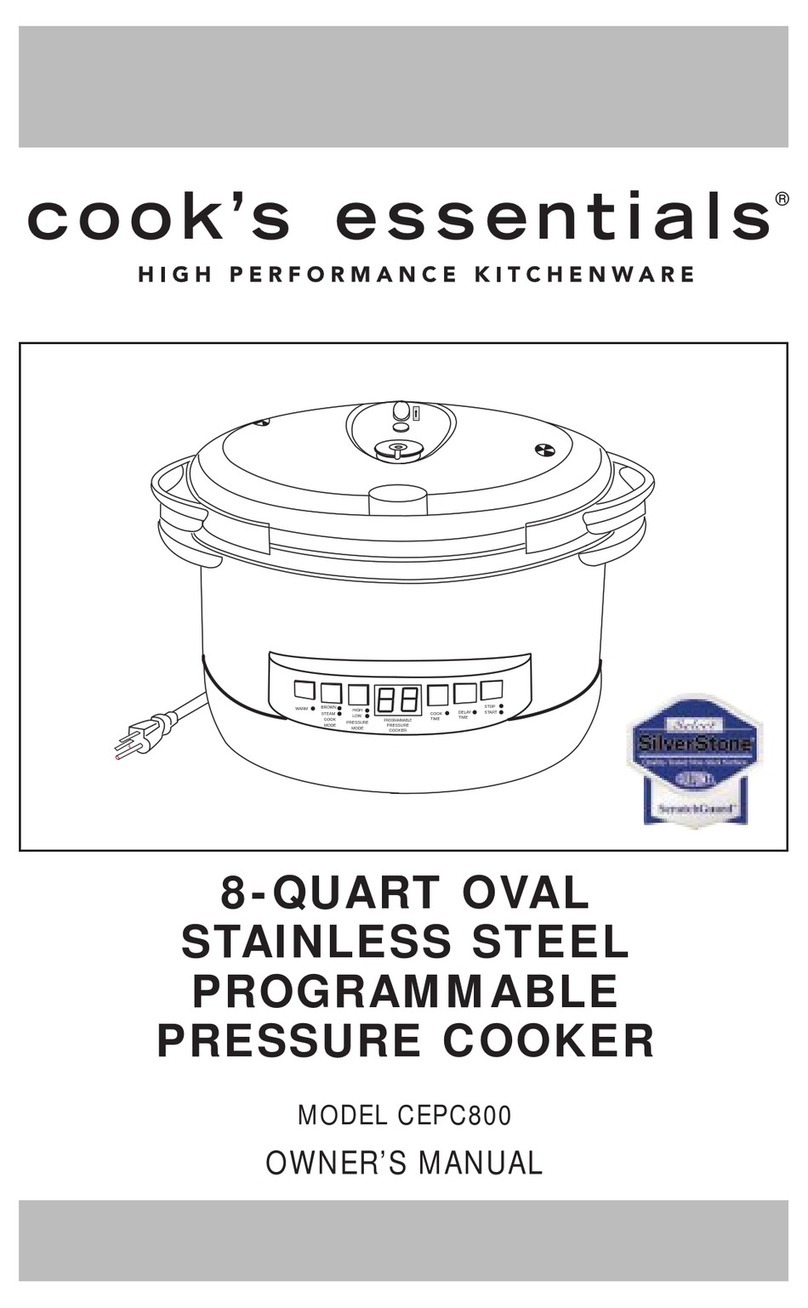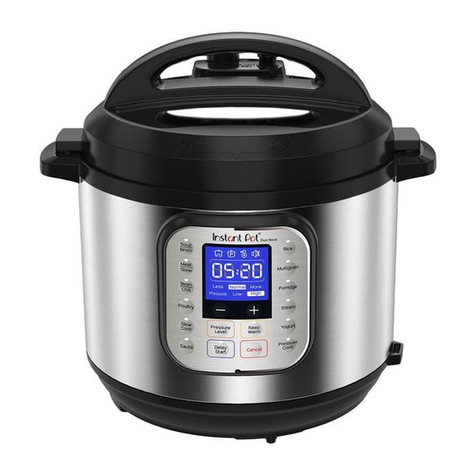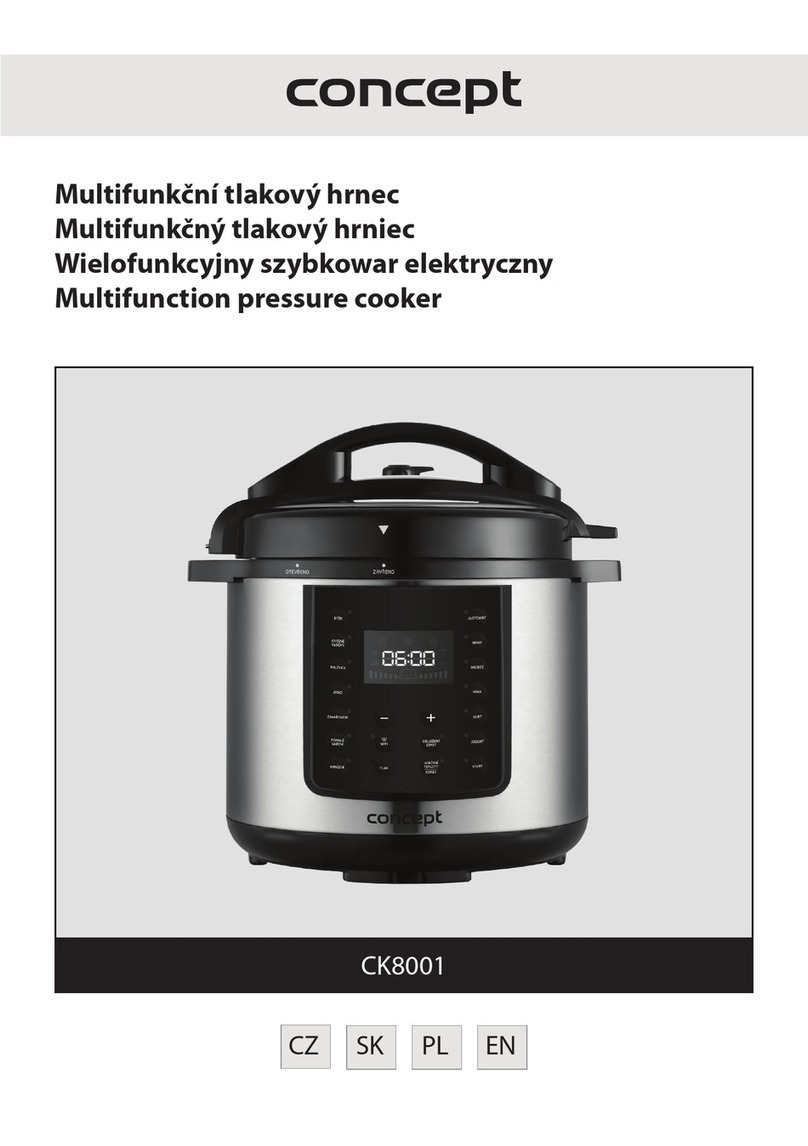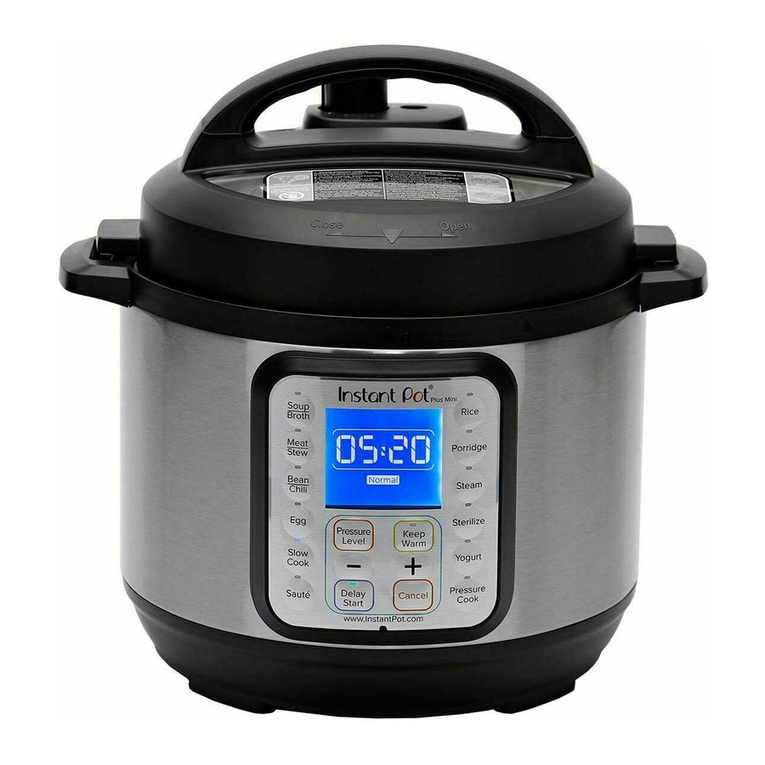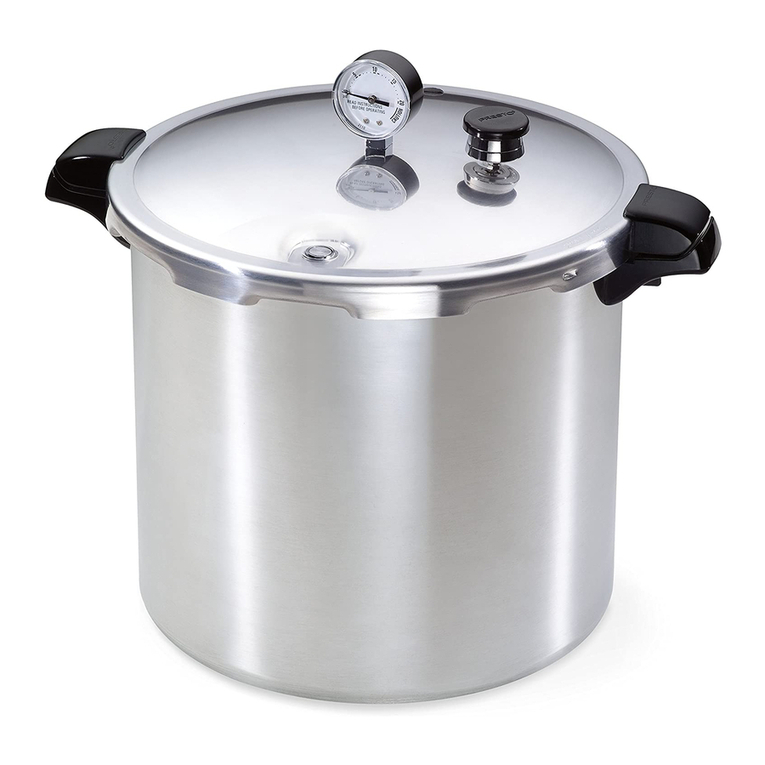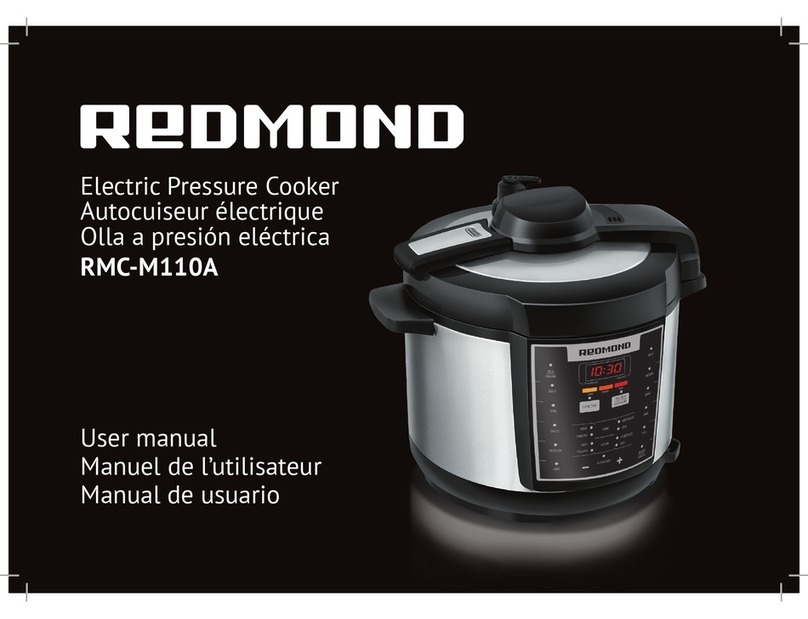Tescoma Bio exclusive User manual

Návod k obsluze a vaření v tlakovém hrnci
Instructions for use and cooking in the pressure cooker
Gebrauchsanleitung und kochen im Schnellkochtopf
Mode d’emploi et cuisson dans la marmite à pression
Istruzioni per l‘uso e cucinare nella pentola a pressione
Instrucciones de uso y cocinar en la olla a presión
Instrucões de utilização e cozinhar na panela de pressão
Instrukcja obsługi i gotowanie w szybkowarze
Návod na použitie a varenie v tlakovom hrnci
Инструкция по эксплуатации и приготовление в скороварке

Špičková kvalita - jednoduché použití - snadná údržba.
Takové jsou výrobky Tescoma - vaše správná volba. Gratulujeme!
CHARAKTERISTIKA
Tlakový hrnec BIO EXCLUSIVE umožňuje vaření pří nízkém nebo při vysokém
tlaku*,což přispívá k zachování přirozené chuti a nutričních hodnot pokrmů. Vaření
s tlakovým hrncem BIO EXCLUSIVE probíhá výrazně rychleji než standardní vaření.
Tlakový hrnec BIO EXCLUSIVE je vyroben z prvotřídní nerezavějící oceli 18/10
a vysoce kvalitních odolných plastů. Rukojeti tlakového hrnce při správném použi-
tí nepálí.
Tlakový hrnec je vybaven 3-mi na sobě nezávislými bezpečnostními pojistkami
a pojistkou proti nechtěnému otevření, jeho použití je zcela bezpečné.
Masivní třívrstvé sendvičové dno má vynikající termoakumulační vlastnosti,
které přispívají k úspoře energie - vaření probíhá rychleji a při nízkém výkonu
sporáku, který je možné vypínat s předstihem ještě před ukončením vaření.
Tlakový hrnec Tescoma BIO EXCLUSIVE je vhodný pro všechny typy sporáků: plynové,
elektrické, sklokeramické i indukční.
*Pracovní tlak v nádobě během vaření pří nízkém tlaku je 0,55 bar.
Pracovní tlak v nádobě během vaření při vysokém tlaku je 0,80 bar.
POPIS TLAKOVÉHO HRNCE
1. Pracovní ventil
2. Bezpečnostní ventil
3. Poklice
4. Rukojeť poklice
5. Tlačítko otevření / uzavření
6. Pojistka proti nechtěnému otevření
7. Tlaková pojistka - otvor v lemu poklice
8. Silikonové těsnění
9. Nádoba
10. Rukojeť nádoby
11. Úchyt nádoby
12. Sendvičové dno
PŘED PRVNÍM POUŽITÍM
Před prvním použitím si důkladně prostudujte návod k použití. Tlakový hrnec
a všechny jeho části důkladně omyjte teplou vodou s přídavkem saponátu
a vytřete do sucha.
PŘED KAŽDÝM POUŽITÍM
Kontrola ventilů (obr. A, B, C, D)
Pracovní ventil (1)
Pracovní ventil otočte do krajní levé polohy (I) a tahem vzhůru vyjměte z rukojeti
(obr. A). Zkontrolujte, zda je otvor pracovního ventilu čistý. V případě znečištění jej
propláchněte pod proudem vody nebo pročistěte vhodným předmětem, např.
tenkou grilovací jehlicí apod. (obr. B). Po kontrole nasaďte pracovní ventil zpět.
Tlakový hrnec BIO EXCLUSIVE

Bezpečnostní ventil (2)
Stiskněte pojistku uzavření poklice na spodní straně rukojeti (obr. C) a opakovaně
zatlačte na píst bezpečnostního ventilu - píst se musí volně pohybovat
a na okraji šestihranného těla ventilu pružit (obr. D). Po kontrole posuňte tlačítko
otevření / uzavření (5) zpět do přední polohy.
KONTROLU VENTILŮ PROVÁDĚJTE PŘED KAŽDÝM POUŽITÍM A VĚNUJTE JÍ NÁLEŽITOU
POZORNOST.
NÁVOD K POUŽITÍ
Otevírání tlakového hrnce (obr. E)
Posuňte tlačítko otevření / uzavření (5) do přední polohy, přidržte je a otočte poklicí
proti směru hodinových ručiček. Poklici sejměte z nádoby.
PŘI OTEVÍRÁNÍ HRNCE NEPOUŽÍVEJTE NEPŘIMĚŘENOU SÍLU.
Plnění tlakového hrnce (obr. F)
Tlakový hrnec lze z bezpečnostních důvodů plnit maximálně do 2/3 objemu nádoby.
U jídel, která během tepelného zpracování pění nebo bobtnají (např. polévky nebo
luštěniny, rýže apod.), plňte hrnec maximálně do 1/2 objemu nádoby, abyste
zabránili nežádoucímu zanesení ventilů a překypění.
V TLAKOVÉM HRNCI NEVAŘTE BEZ POUŽITÍ VODY - MIN. MNOŽSTVÍ VODY
JE 250 ML.
Uzavírání tlakového hrnce (obr. G)
Položte poklici (3) na nádobu hrnce tak, aby šipka na poklici a šipka na rukojeti
nádoby směřovaly proti sobě. Poklicí otočte po směru hodinových ručiček tak, aby
se rukojeti kryly. Ozve se „cvaknutí“ a tlačítko otevření/uzavření se automaticky
posune do zadní polohy. Pokud se tak nestane, posuňte tlačítko do zadní polohy
ručně.
PŘI UZAVÍRÁNÍ HRNCE NEPOUŽÍVEJTE NEPŘIMĚŘENOU SÍLU!
Vaření v tlakovém hrnci (obr. H, J, K)
NÍZKÝ NEBO VYSOKÝ TLAK ZVOLTE POOTOČENÍM PRACOVNÍHO VENTILU DO
PŘÍSLUŠNÉ POLOHY.
1. Pokud si přejete vařit při nízkém tlaku, otočte pracovní ventil do polohy
„1“. Vaření při nízkém tlaku je ideální pro šetrnou tepelnou úpravu pokrmů,
např. k přípravě zeleniny, ovoce, luštěnin, ryb apod. (obr. H).
2. Pokud si přejete vařit při vysokém tlaku, otočte pracovní ventil do
polohy „2“. Vaření při vysokém tlaku je rychlejší a probíhá při vyšší
teplotě. Hodí se zejména k přípravě masa a pokrmů, které vyžadují
delší tepelné zpracování (obr. J).
3. Správně naplněný a uzavřený hrnec se zvoleným nízkým nebo vysokým
tlakem postavte na sporák nastavený na nejvyšší stupeň.
4. Po krátké chvíli začne z otvoru bezpečnostního ventilu pod rukojetí s mírným
syčením ucházet pára - toto syčení za okamžik ustane a bezpečnostní
pojistka proti nechtěnému otevření (6) se vysunenahoru.Toznamená, že
tlak v nádobě dosáhl požadované hodnoty a pára v tu chvíli začne ucházet
z pracovního ventilu (obr. K).

5. Snižte výkon sporáku tak, aby z pracovního ventilu ucházelo jen malé
množství páry. Obvykle postačí nízký výkon sporáku.
6. Měnit nastavení nízkého nebo vysokého tlaku během vaření
nedoporučujeme. Pokud je to nutné, použijte ke změně tlaku vhodný
předmět, např. vidličku nebo použijte kuchyňskou rukavici.
Pozor! V průběhu vaření může nepatrné množství páry unikat též z otvoru
bezpečnostního ventilu pod rukojetí.
UPOZORNĚNÍ
Pokud na počátku vaření z tlakového hrnce uniká velké množství páry, není tlakový
hrnec správně uzavřen. Nesprávné uzavření je obvykle způsobeno:
a) Poklice není správně nasazena - zopakujte uzavření hrnce.
b) Pracovní ventil je nastaven do polohy pro vypouštění páry - nastavte
jej do polohy pro vaření při nízkém nebo vysokém tlaku.
c) Silikonové těsnění není správně osazeno v poklici - zkontrolujte jeho
umístění.
d) Silikonové těsnění je poškozeno - vyměňte jej za nové originální těsnění
značky Tescoma.
Ukončení vaření (obr. L)
PÁRU VYPOUŠTĚJTE VŽDY AŽ PO ODSTAVENÍ HRNCE ZE SPORÁKU!
Po uplynutí doby potřebné k uvaření pokrmů sejměte tlakový hrnec ze sporáku
a to i v případě, že je sporák již vypnutý.
Ponechte tlakový hrnec chvíli odstavený, aby teplota a tlak v hrnci mohly samovolně
poklesnout.
Otočte pracovní ventil do polohy pro vypouštění páry ( ) a vypusťte páru z hrnce
(obr. L).
Bezpečnostní pojistka proti nechtěnému otevření se po vypuštění páry zasune a tlakový
hrnec je možné otevřít (obr. E).
Pokud je bezpečnostní pojistka proti nechtěnému otevření vysunutá v horní poloze
a tlakový hrnec nelze otevřít, znamená to, že je v nádobě stále tlak. Ujistěte se,
že je pracovní ventil nastaven do polohy pro vypouštění páry. Pokud tlakový hrnec
přesto nelze otevřít, vložte jej do dřezu a ochlaďte poklici malým množstvím
pomalu stékající studené vody, dokud se červená bezpečnostní pojistka proti
nechtěnému otevření sama nezasune.
TLAKOVÝ HRNEC NIKDY NEOCHLAZUJTE PRUDCE, NENECHTE VODU STÉKAT
NA PLASTOVÉ ČÁSTI A HRNEC NENOŘTE DO VODY CELÝ. PŘI OTEVÍRÁNÍ HRNCE
NEPOUŽÍVEJTE NEPŘIMĚŘENOU SÍLU.
BEZPEČNOSTNÍ SYSTÉMY
TŘI SAMOSTATNÉ BEZPEČNOSTNÍ POJISTKY A POJISTKA PROTI NECHTĚNÉMU
OTEVŘENÍ.
Pracovní ventil
Pracovní ventil reguluje nízký a vysoký tlak, průběžně vypouští přebytečnou
páru a po ukončení vaření vypouští z hrnce veškerou páru.

Bezpečnostní ventil
Bezpečnostní ventil funguje jako pojistka při zanesení pracovního ventilu.
V případě, že během vaření pára přestane unikat z pracovního ventilu a začne
intenzivně unikat z ventilu bezpečnostního, hrnec ihned odstavte. Po vychladnutí
hrnec otevřete a vyčistěte pracovní ventil.
Pozor! Nepatrné množství páry může unikat během vaření i z bezpečnostního ventilu.
Otvor v lemu poklice
Pokud dojde k zanesení pracovního i bezpečnostního ventilu současně, tlak
v hrnci vytlačí silikonové těsnění otvorem v lemu poklice, čímž dojde k okamžitému
snížení tlaku a úniku páry.
POKUD DOJDE PŘI POUŽITÍ TLAKOVÉHO HRNCE K PROTLAČENÍ SILIKONOVÉHO
TĚSNĚNÍ OTVOREM V LEMU POKLICE, TLAKOVÝ HRNEC SAMI NEOPRAVUJTE, ALE
PŘEDEJTE JEJ DO ODBORNÉHO SERVISU.
Pojistka proti nechtěnému otevření
Zabraňuje nechtěnému otevření dokud z tlakového hrnce neunikne veškerá pára
a tlak.
PRAKTICKÁ DOPORUČENÍ
K VAŘENÍ VOLTE VŽDY ODPOVÍDAJÍCÍ VELIKOST PLOTÝNKY NEBO PLAMENE.
Průměr plotýnky musí být stejný nebo menší než je průměr dna hrnce! Plamen
nesmí nikdy přesahovat okraje dna hrnce. Při vaření na plynu používejte rozpty-
lovací síťku nebo varnou plotýnku.
VYUŽÍVEJTE TERMOAKUMULAČNÍCH VLASTNOSTÍ TŘÍVRSTVÉHO SENDVIČOVÉHO
DNA.
Sporák vypínejte s předstihem ještě před ukončením vaření. Díky třívrstvému
sendvičovému dnu je akumulovaná tepelná energie předávána do hrnce i po vypnutí
sporáku.
SKLADOVÁNÍ, ÚDRŽBA A ČIŠTĚNÍ
TLAKOVÝ HRNEC SKLADUJTE S NENASAZENOU POKLICÍ.
Poklice
Poklici tlakového hrnce nemyjte v myčce nádobí!
Otvor pracovního ventilu čistěte propláchnutím pod proudem vody, v případě silného
znečištění jej vyčistěte pomocí vhodného kovového nástroje - např. tenké grilovací
jehlice (obr. B).
Bezpečnostní ventil vyčistěte opakovaným stlačením pod tekoucí vodou. Pracovní
ani bezpečnostní ventil, rukojeti ani jiné části poklice nedemontujte.
Nádoba
Nádobu tlakového hrnce lze mýt v myčce.
Objeví-li se uvnitř hrnce bílé usazeniny vodního kamene, vyčistěte je octem, něko-
lika kapkami citronu nebo speciálním prostředkem na čištění nerezového nádobí
CLINOX. Bílé skvrny nijak neomezují funkčnost či zdravotní nezávadnost nádobí,
nejsou vadou výrobku a nemohou být předmětem reklamace. Při přehřátí hrn-
ce se na povrchu může objevit fialové až hnědé zabarvení. Toto zabarvení neomezuje
funkčnost či zdravotní nezávadnost hrnce, není vadou výrobku a nemůže být před-
mětem reklamace.

Na nádobu tlakového hrnce nenechávejte nikdy dlouhodobě působit saponáty,
a to ani vodou ředěné. Uvnitř nádoby neskladujte zbytky pokrmů.
Silikonové těsnění
Těsnění tlakového hrnce je vyrobeno z prvotřídního silikonu a vydrží cca 500 hodin
provozu. Po každém použití tlakového hrnce vyjměte těsnění z poklice, umyjte,
osušte, potřete lehce potravinářským olejem nebo tukem a vložte zpět.
Pokud těsnění vykazuje jakékoliv známky netěsnosti nebo ztrátu pružnosti, je třeba
jej okamžitě vyměnit za nové značkové těsnění Tescoma.
Pokud tlakový hrnec nepoužíváte intenzivně, měňte těsnění pravidelně ve dvou-
letých cyklech.
POUŽÍVEJTE ZÁSADNĚ NÁHRADNÍ DÍLY ZNAČKY TESCOMA.
BEZPEČNOSTNÍ POKYNY (dle EN 12778)
1. Před prvním použitím si důkladně prostudujte Návod k obsluze.
2. Tlakový hrnec nepoužívejte pro jiné účely, než k vaření potravin.
3. Před každým použitím zkontrolujte funkčnost pracovního
a bezpečnostního ventilu.
4. Během vaření manipulujte s tlakovým hrncem s maximální
opatrností, nikdy se nedotýkejte jeho horkých částí.
5. Během vaření zamezte přístupu dětí do blízkosti tlakového hrnce.
6. Tlakový hrnec plňte maximálně do 2/3 objemu nádoby, při přípravě
pokrmů,kterévařenímbobtnají,jakojsourýže,luštěniny,těstoviny
apod., plňte tlakový hrnec max. do 1/2 objemu nádoby. Při vaření
těstovin pod tlakem hrncem před otevřením zatřeste. Nikdy
nevařte bez použití vody.
7. Do tlakového hrnce nevkládejte jídla zabalená do tkaniny, papíru
nebo plastikových obalů. Pokrmy, u kterých dochází ke zvětšení
objemu (např. maso s kůží, hovězí jazyk apod.), nikdy nepropi-
chujte, dokud je kůže nabobtnalá - nebezpečí opaření.
8. Tlakový hrnec neotvírejte, aniž byste zcela snížili tlak uvnitř
nádoby. Nikdy při otvírání hrnce nepoužívejte sílu.
9. Tlakový hrnec nedávejte do vyhřáté pečící trouby a nepoužívejte
ke smažení pod tlakem.
10. Nezasahujte do žádného systému hrnce nad rámec návodu
k použití - opravu svěřte vždy odbornému servisu, nikdy nepouží-
vejte jiné, než originální náhradní díly.
POZOR!
SLOUŽÍ K TEPELNÉ ÚPRAVĚ POKRMŮ POD TLAKEM. NESPRÁVNÉ POUŽITÍ
NEBO ÚDRŽBA MOHOU ZPŮSOBIT ZRANĚNÍ!

Poznámky:

MASO - VYSOKÝ TLAK
Hovězí maso čas v min
Roláda 20-30
Pečeně 30-40
Svíčková 30-40
Polévkové maso 35-40
Jazyk 45
Vepřové maso
Uzený bůček 20
Roláda 20-30
Ovarové kolínko 25-30
Pečeně 30-35
Telecí maso
Pečeně 12-15
Hlava 15
Nožička 15-20
Jazyk 15-20
Jehněčí a skopové maso
Kýta 30
Drůbeží maso
Holoubě 8-10
Kuře 15
Slepice 15-20
Husí drůbky 15
Zvěřina
Králík 15
Zaječí pečeně 15
Srnčí hřbet 10
Srnčí kýta 20-30
OBILOVINY - VYSOKÝ TLAK
Oves a kukuřice
Ovesná mouka 5
Ovesné vločky 6
Ovesná krupice 6
Kukuřice 10
RYBY, OVOCE A ZELENINA - NÍZKÝ
TLAK
Ryby čas v min
Dle velikosti porce 6-8
Brambory
Brambory krájené solené 7-9
Brambory ve slupce 10-15
Ovoce
Jablka krájená 2-5
Hrušky krájené 2-5
Zelenina
Špenát 2-3
Paprika 3-4
Celer krájený 3-5
Česnek krájený 4
Brokolice 5-6
Zavařené fazole 5-6
Kedlubny 5-6
Mrkev 6-8
Chřest 6-10
Růžičková kapusta 8-10
Hlávkové zelí 7-12
Květák dělený 8-9
Červené zelí 8-10
Kysané zelí 10-12
Květák celý 15-18
POLÉVKY A LUŠTĚNINY - NÍZKÝ
TLAK
Polévky
Houbová 2-5
Masový vývar 25-30
Slepičí vývar 25-30
Volská oháňka 25-30
Luštěniny
Namočený hrách 10-12
Namočené fazole 25-30
RÝŽE – NÍZKÝ TLAK
Rýžová kaše 7-8
Rizoto 5-7
Uvedené doby vaření jsou měřeny od okamžiku, kdy z pracovního ventilu začne unikat
pára. V tom okamžiku přepněte sporák na nízký výkon. Všechny uvedené časy jsou
pouze orientační a jsou závislé na druhu připravovaných surovin, jejich množství,
kvalitě, výchozí teplotě, typu sporáku apod. Odchylky od uvedených časů nejsou
vyloučeny, přesné časy stanovíte na základě vlastních zkušeností.
ORIENTAČNÍ ČASY PRO VAŘENÍ V TLAKOVÉM HRNCI BIO EXCLUSIVE

ZÁRUČNÍ LIST
Na tento výrobek je poskytována záruční doba 5 roků ode dne prodeje. Tento záruční
list předkládejte s platným potvrzením o zakoupení výrobku. Poskytnutím záruky
nejsou dotčena práva kupujícího, která se ke koupi věci váží podle zvláštních práv-
ních předpisů. Záruční doba začíná dnem prodeje.
Výrobek:
Prodejce (obchodní název a adresa):
Datum prodeje:
Razítko a podpis prodejce:
Záruka se zásadně nevztahuje na tyto případy:
- výrobek byl používán v rozporu s návodem k použití
- na výrobku byly provedeny neautorizované opravy a změny
- na výrobku byly použity jiné než originální náhradní díly
- závady byly způsobeny úderem či pádem
- výrobek byl opotřebován běžným užíváním, kromě zjevných materiálových vad.
Oprávněnou reklamaci uplatňujte u prodejce, u kterého jste výrobek zakoupili nebo
přímo v servisních střediscích Tescoma. Aktuální seznam servisních středisek na
www.tescoma.com.

Top quality - easy to use - easy maintenance.
Tescoma products - the right choice. Congratulations!
CHARACTERISTICS
The BIO EXCLUSIVE pressure cooker enables cooking at low or high pressure*,
which contributes to preserving the natural taste and nutritional value of meals.
Cooking with the BIO EXCLUSIVE pressure cooker is significantly faster than standard
cooking.
The BIO EXCLUSIVE pressure cooker is made of high-grade 18/10 stainless steel
and high-quality resistant plastics. The handles of the pressure cooker do not burn
if used properly.
The pressure cooker is provided with 3 independent safety cut-outs and a lock
against accidental opening; it is therefore entirely safe to use.
The solid three-layer sandwich bottom has excellent heat retaining properties
that help to economise on energy - cooking is faster and at a low heat output;
the heat may be switched off in advance before the end of cooking.
The Tescoma BIO EXCLUSIVE pressure cooker is suitable for all types of cooker: gas,
electric, vitro-ceramic and induction cookers.
* The operating pressure in the vessel is 0,55 bar during low-pressure cooking.
The operating pressure in the vessel is 0,80 bar during high-pressure cooking.
PRESSURE COOKER DESCRIPTION
1. Operating valve
2. Safety valve
3. Lid
4. Lid handle
5. Open / close button
6. Lock against accidental opening
7. Pressure cut-out - aperture in the rim of the lid
8. Silicone seal
9. Vessel
10. Vessel handle
11. Vessel grip
12. Sandwich bottom
BEFORE FIRST USE
Thoroughly study the instructions for use before first use. Thoroughly wash the
pressure cooker and all its parts with warm water and detergent and wipe dry.
BEFORE EACH USE
Inspecting the valves (Figures A, B, C, D)
Operating valve (1)
Position the operating valve to the end left position (I) and remove it from the handle
by pulling it upwards (Fig. A). Check if the operating valve aperture is clean. If soiled,
flush it under running water or clean it using a suitable object such as a thin skewer
etc. (Fig. B). Attach the operating valve back to position after inspecting it.
Pressure cooker BIO EXCLUSIVE

Safety valve (2)
Push the lid closure lock on the bottom of the handle (Fig. C) and repeatedly press
the piston of the safety valve - the piston must freely move and spring at the
edge of the valve’s hexagonal body (Fig. D). After the inspection, move the open/
close button (5) back to the front position.
INSPECT THE VALVES BEFORE EACH USE, APPLYING DUE CARE.
INSTRUCTIONS FOR USE
Opening the pressure cooker (Fig. E)
Move the open/close button (5) to the front position, hold it and turn the lid coun-
ter clockwise. Remove the lid from the vessel.
DO NOT APPLY INAPPROPRIATE FORCE WHEN OPENING THE PRESSURE COOKER.
Filling the pressure cooker (Fig. F)
For safety reasons, the pressure cooker must be filled to a maximum of 2/3 vessel
capacity.
With foods that tend to froth or swell when heated (such as soups or lentils, rice,
etc.), fill the pressure cooker to a maximum of 1/2 vessel capacity to avoid un-
wanted clogging of valves and overboiling.
DO NOT COOK WITHOUT WATER IN THE PRESSURE COOKER - THE MINIMUM
AMOUNT OF WATER IS 250 ML.
Closing the pressure cooker (Fig. G)
Place the lid (3) onto the vessel of the pressure cooker so that the arrow on the lid
and the arrow on the handle of the vessel point against each other. Turn the lid
clockwise so that the handles are aligned. A click sound will be heard and the
open / close button will automatically move to the back position. If this does not
happen, move the button to the back position manually.
DO NOT APPLY INAPPROPRIATE FORCE WHEN CLOSING THE PRESSURE COOKER!
Cooking in the pressure cooker (Figures H, J, K)
SELECT LOW OR HIGH PRESSURE BY TURNING THE OPERATING VALVE TO THE RE-
LEVANT POSITION.
1. If you wish to cook at a low pressure, turn the operating valve to position
“1”. Cooking at a low pressure is ideal for economic cooking of meals, for
example for cooking vegetables, fruits, lentils, fish, etc. (Fig. H).
2. I f y o u wis h t o c ook a t a highpressure,turntheoperatingvalve to position
“2”. Cooking at a high pressure is quicker and uses a higher temperature.
It is suitable in particular for cooking meat and meals that require a longer
thermal treatment (Fig. J).
3. Place the correctly filled and closed pressure cooker set to a low or high
pressure onto a heat source set to the highest output.
4. After a short while steam will begin to escape with moderate hissing
from the safety valve aperture; the hissing will cease after a moment
and the safety lock against accidental opening (6) will slip upwards.
This means that the pressure in the vessel has reached the required level;
at this moment steam begins to escape from the operating valve (Fig. K).

5. Reduce heat output so that only a small amount of steam escapes
from the operating valve. A low heat output will usually be enough.
6. We do not recommend changing the low / high pressure setting while
cooking. If this is necessary, use a suitable tool to change the pressure
such as a fork or oven mitten.
Warning! A minute amount of steam may also escape from the aperture of the safety
valve under the handle during the cooking process.
WARNING
If a large amount of steam escapes from the pressure cooker at the beginning of
the cooking process, the pressure cooker has not been correctly closed. Incorrect
closing is usually due to the following:
a) The lid is attached incorrectly - close the pressure cooker again.
b) The operating valve is set to the steam release position - set it to the low
or high pressure cooking position.
c) The silicone seal is incorrectly positioned in the lid - check its position
d) The silicone seal is faulty - replace it with a new original Tescoma seal.
Cooking termination (Fig. L)
ALWAYS RELEASE STEAM ONLY AFTER REMOVING THE PRESSURE COOKER FROM
HEAT!
After the time required for cooking your meal elapses, remove the pressure cooker
from the heat source even if the latter has already been switched off.
Leave the pressure cooker aside for a while to allow the temperature and pressure
in the pressure cooker to drop spontaneously.
Turn the operating valve to the steam release position ( ) and release steam from
the pressure cooker (Fig. L).
The safety lock against accidental opening slips in after the steam is released and the
pressure cooker can be opened (Fig. E).
If the safety lock against accidental opening is in the upper position and the pres-
sure cooker cannot be opened, pressure still remains in the vessel. Make sure
that the operating valve is set to the steam release position. If the pressure cooker
still cannot be opened, put it into the sink and cool the lid with a small amount of
slowly running water until the red safety lock against accidental opening slips
in automatically.
NEVER COOL THE PRESSURE COOKER ABRUPTLY, DO NOT LET WATER RUN ONTO
PLASTIC PARTS AND DO NOT IMMERSE THE ENTIRE PRESSURE COOKER IN WATER.
DO NOT APPLY INAPPROPRIATE FORCE WHEN OPENING THE PRESSURE COOKER.
SAFETY SYSTEMS
THREE INDEPENDENT SAFETY CUT-OUTS AND A LOCK AGAINST ACCIDENTAL
OPENING.
Operating valve
The operating valve controls low and high pressure, continuously releases exces-
sive steam and releases all steam from the pressure cooker after the cooking process
fi n i s h e s .

Safety valve
The safety valve operates as a cut-out activated when the operating valve be-
comes clogged. Immediately remove the pressure cooker from the heat source
if steam ceases to escape from the operating valve during cooking and escapes in-
tensely from the safety valve. After the pressure cooker cools down, open it and
clean the operating valve.
Warning! A minute amount of steam may escape also from the safety valve during
cooking.
Aperture in the rim of the lid
If the operating valve and the safety valve become clogged at once, the pressure in
the pressure cooker pushes the silicone seal through the aperture in the rim of
the lid,which causes an immediate drop in pressure and steam release.
IF THE SILICONE SEAL IS PUSHED THROUGH THE APERTURE IN THE RIM OF THE LID
WHEN USING THE PRESSURE COOKER, DO NOT REPAIR THE PRESSURE COOKER
YOURSELF; INSTEAD BRING IT FOR PROFESSIONAL SERVICING.
Lock against accidental opening
Prevents accidental opening until all steam and pressure escape from the pressure
cooker.
PRACTICAL RECOMMENDATIONS
ALWAYS USE AN APPROPRIATE SIZE OF COOKING RANGE OR FLAME FOR
COOKING.
The diameter of the cooking range must be identical or smaller than the diameter
of the bottom of the pressure cooker! Flame must never expand beyond the bot-
tom of the pressure cooker.Use the dispenser net or cooking range when cooking
on gas.
MAKE USE OF THE HEAT RETAINING PROPERTIES OF THE THREE-LAYER SANDWICH
BOTTOM.
Switch the heat off in advance before the end of cooking. Thanks to the three-
layer sandwich bottom, the accumulated heat energy is transferred into the pressure
cooker even after the heat has been switched off.
STORAGE, MAINTENANCE AND CLEANING
STORE THE PRESSURE COOKER WITH THE LID UNATTACHED.
Lid
Do not wash the lid of the pressure cooker in dishwasher!
Clean the operating valve aperture by flushing it with running water; if excessively
soiled, clean it using a suitable metal tool such as a thin skewer (Fig. B).
Clean the safety valve by repeatedly pushing it under running water. Do not disas-
semble the operating valve, the safety valve, the handles or any other parts of the
lid.
Vessel
The vessel of the pressure cooker is dishwasher safe.
Should white stains due to scale formation appear inside the pressure cooker, use
vinegar, lemon drops or the special stainless steel cleaning agent CLINOX. The
white stains do not affect functioning of the cookware and are not hazardous for

health. As such they do not represent a fault and cannot be claimed. When the
cooker is overheated,purple to brown stains might appear on the surface. These
stains do not affect correct functioning of the cookware and are not hazardous for
health. As such they do not represent a fault and cannot be claimed.
Never expose the pressure cooker vessel to detergents including water-soluble de-
tergents for prolonged periods of time. Do not store remaining foods inside the
vessel.
Silicone seal
The pressure cooker seal is made of excellent silicone that lasts for about 500 hours
of operation. Remove the seal from the lid after each use of the pressure cooker,
wash it and dry, lightly smear with cooking oil or fat and insert back.
If the seal shows any signs of leakage or loss of flexibility, it must be immediately
replaced with a new Tescoma brand seal.
If using the pressure cooker intensely, replace the seal regularly at two-year in-
tervals.
ALWAYS USE TESCOMA SPARE PARTS.
SAFETY INSTRUCTIONS (under EN 12778)
1. Read the Instructions for use thoroughly before first use.
2. Never use the pressure cooker for other purposes than cooking
meals.
3. Check the operating and safety valves for proper functioning
prior to each use.
4. Handle the pressure cooker with utmost care when cooking;
never touch the hot parts.
5. Avoid children coming near the pressure cooker while cooking.
6. Fill the pressure cooker to a maximum of 2/3 vessel capacity;
when cooking foods that tend to swell when cooked such as rice,
lentils, etc., fill the pressure cooker to a maximum of 1/2 vessel
capacity. Shake the vessel before opening when cooking pasta
in pressurised environment. Never cook without water.
7. Never put meals wrapped in fabric, paper or plastic materials
into the pressure cooker. Never pierce foods that tend to expand
in volume such as meat with skin, beef tongue, etc. while the
skin is enlarged to avoid scalding.
8. Do not open the pressure cooker without entirely reducing
pressure inside the vessel. Never apply force when opening
the vessel.
9. Do not put the pressure cooker inside a heated oven and do not
use it for frying in a pressurised environment.
10. Do not intervene in any system within the vessel beyond
the Instructions for use - contact a professional service for
repairs and use nothing other than original spare parts.

ATTENTION!
INTENDED FOR HEAT TREATMENT OF FOODS IN A PRESSURISED ENVIRON-
MENT. IMPROPER USE OR MAINTENANCE CAN CAUSE INJURY!
Notes:

MEAT - HIGH PRESSURE
Beef time in min
Roll 20-30
Roast beef 30-40
Sirloin 30-40
Soup meat 35-40
Tongue 45
Pork
Smoked side 20
Roll 20-30
Boiled pork knuckle 25-30
Roast 30-35
Veal
Roast 12-15
Head 15
Leg 15-20
Tongue 15-20
Lamb and mutton
Leg 30
Poultry
Squab 8-10
Chicken 15
Hen 15-20
Giblets 15
Venison
Rabbit 15
Roasted hare 15
Venison back 10
Venison leg 20-30
CEREALS - HIGH PRESSURE
Oat and maize
Oat flour 5
Oat flakes 6
Gristles 6
Maize 10
FISH, FRUITS AND VEGETABLES
- LOW PRESSURE
Fish time in min
Depending on amount 6-8
Potatoes
Sliced salted potatoes 7-9
Potatoes in their jackets 10-15
Fruit
Sliced apples 2-5
Sliced pears 2-5
Vegetables
Spinach 2-3
Pepper 3-4
Sliced celery 3-5
Sliced garlic 4
Broccoli 5-6
Sterilised beans 5-6
Kohlrabi 5-6
Carrot 6-8
Asparagus 6-10
Sprouts 8-10
Cabbage 7-12
Cut cauliflower 8-9
Red cabbage 8-10
Sauerkraut 10-12
Whole cauliflower 15-18
SOUPS AND LENTILS
- LOW PRESSURE
Soups
Mushroom soup 2-5
Broth 25-30
Chicken bouillon 25-30
Oxtail 25-30
Lentils
Soaked peas 10-12
Soaked beans 25-30
RICE - LOW PRESSURE
Rice milk 7-8
Risotto 5-7
The times given below are measured from the moment steam begins to escape from
the operating valve. When this happens, set to a low heat output. All the times given
below are for reference only and depend on the ingredients, their quantity, quality,
initial temperature, type of heat source, etc. Deviations from the indicated times
might occur; you will determine accurate times based on your own experience.
REFERENCE TIMES OF COOKING IN THE BIO EXCLUSIVE PRESSURE COOKER

WARRANTY CERTIFICATE
A 5-year warranty period applies to this product from the date of purchase. Present
this warranty certificate with a valid purchase receipt. Provision of the warranty does
not prejudice the purchaser’s rights applicable to the purchase under the special
legal regulations. The warranty period commences on the date of purchase.
Product:
Retailer (trade name and address):
Date of purchase:
Retailer’s stamp and signature:
The warranty does not cover:
- improper use of the product incompatible with the Instructions for use
- unauthorised repairs of and alterations to the product
- anything other than the original spare parts used in the product
- defects resulting from an impact or fall
- everyday wear and tear of the product, with the exception of obvious material
defects.
If you feel your complaints are justified, please contact your retailer or a Tescoma
servicing centre directly. For a current list of the servicing centres, please refer to
www.tescoma.com.

Spitzenqualität - einfacher Gebrauch - leichte Pflege.
Dies sind die Produkte Tescoma - Ihre richtige Wahl. Wir gratulieren Ihnen!
EIGENSCHAFTEN
Mit dem Schnellkochtopf BIO EXCLUSIVE ist es möglich, beim niedrigen oder hohen
Druck zu kochen*, wobei der natürliche Geschmack sowie der Nährwert der Spei-
sen erhalten bleiben. Das Kochen im Schnellkochtopf BIO EXCLUSIVE erfolgt markant
schneller als der übliche Kochvorgang.
Der Schnellkochtopf BIO EXCLUSIVE ist aus erstklassigem rostfreien Edelstahl 18/10
und hochwertigen festen Kunststoffen hergestellt. Beim richtigen Gebrauch werden
die Griffe des Schnellkochtopfes nicht heiß.
Der Schnellkochtopf ist mit drei voneinander unabhängigen Sicherheitssyste-
men und mit einer Sicherung gegen unbeabsichtigtes Öffnen ausgestattet, der
Kochvorgang ist voll betriebssicher.
Der massive dreischichtige Sandwich-Boden hat ausgezeichnete Wärmeleit-
Eigenschaften, die Energieersparnis bringen - das Kochen erfolgt schneller und bei
der niedrigen Leistungsstufe, der Kochherd kann ausgeschaltet werden, bevor
das Gargut fertig gekocht ist.
Der Schnellkochtopf BIO EXCLUSIVE ist für alle Herdarten geeignet - Gas-, Elektro-,
glaskeramische sowie Induktionsherde.
* Der Arbeitsdruck im Kochgefäß während des Kochens unter dem niedrigen Druck
beträgt 0,55 bar. Der Arbeitsdruck im Kochgefäß während des Kochens unter dem
hohen Druck beträgt 0,80 bar.
BESCHREIBUNG DES SCHNELLKOCHTOPFES
1. Arbeitsventil
2. Sicherheitsventil
3. Deckel
4. Deckelgriff
5. Entriegelungs- / Verriegelungsknopf
6. Sicherung gegen unbeabsichtigtes Öffnen
7. Drucksicherung - Loch im Deckelrand
8. Silikon-Dichtung
9. Topf
10. Handgriff des Topfes
11. Griffe des Topfes
12. Sandwich-Boden
VOR DEM ERSTEN GEBRAUCH
Vor dem ersten Gebrauch sorgfältig die Gebrauchsanleitung durchlesen. Den Schnell-
kochtopf und sämtliche Teile gründlich mit warmem Wasser mit Reinigungsmittel
abwaschen und trockenwischen.
VOR JEDEM GEBRAUCH
Überprüfung der Ventile (Abb. A, B, C, D)
Arbeitsventil (1)
Das Arbeitsventil in die linke Endposition (I) drehen und aus dem Handgriff heraus-
Schnellkochtopf BIO EXCLUSIVE

nehmen (Abb. A). Die Öffnung des Arbeitsventils auf Verschmutzung überprüfen. Im
Falle der Verschmutzung ist es unter fließendem Wasser durchzuspülen, bzw. mit
einem geeigneten Gegenstand wie z.B. feine Grillnadel zu reinigen (Abb. B). Nach der
Überprüfung ist das Arbeitsventil wieder aufzusetzen.
Sicherheitsventil (2)
Die Sicherung für richtiges Schließen des Deckels auf der Unterseite des Deckels drük-
ken (Abb. C) und mehrmals auf den Kolben des Sicherheitsventils drücken -
der Kolben muss frei beweglich sein und am Rand des sechskantigen Ventilkörpers
federn (Abb. D). Nach der Überprüfung ist der Entriegelungs-/Verriegelungsknopf (5)
zurück in die vordere Stellung zu schieben.
VOR JEDEM GEBRAUCH SIND DIE VENTILE SORGFÄLTIG ZU ÜBERPRÜFEN.
GEBRAUCHSANLEITUNG
Öffnen des Schnellkochtopfes (Abb. E)
Den Entriegelungs- / Verriegelungsknopf (5) in die vordere Stellung schieben, gedrückt
halten und den Deckel gegen Uhrzeigersinn umdrehen. Den Deckel vom Topf ab-
nehmen.
DEN SCHNELLKOCHTOPF NIE GEWALTSAM ÖFFNEN.
Befüllen des Schnellkochtopfes (Abb. F)
Aus den Sicherheitsgründen kann man den Schnellkochtopf max. zu 2/3 des Topfvo-
lumens befüllen.
Bei den Gerichten, die beim Kochen schäumen oder quellen (z.B. Suppen oder Hülsen-
früchte, Reis, usw.), ist der Schnellkochtopf max. zu 1/2 des Topfvolumens befüllen,
um die unerwünschte Verschmutzung, bzw. das Überlaufen zu vermeiden.
IM SCHNELLKOCHTOPF NIE OHNE WASSER KOCHEN - MIN. WASSERMENGE BETRÄGT
250 ML.
Schließen des Schnellkochtopfes (Abb. G)
Den Deckel (3) auf den Topf setzen, wobei die Pfeile auf dem Deckel und auf dem
Handgriff des Topfes gegenüberstehen sollen. Den Deckel im Uhrzeigersinn drehen,
die Griffe müssen miteinander passen. Es ist ein „Klick“ zu hören und der Entriege-
lungs- / Verriegelungsknopf steht automatisch in der hinteren Stellung. Ist es nicht
der Fall, muss der Entriegelungs- / Verriegelungsknopf manuell in die hintere Stellung
gebracht werden.
DEN SCHNELLKOCHTOPF NIE GEWALTSAM SCHLIESSEN!
Kochen im Schnellkochtopf (Abb. H, J, K)
DIE NIEDER-, BZW. HOCHDRUCKSTUFE IST MIT DEM UMDREHEN DES ARBEITSVENTILS
IN DIE GEWÜNSCHTE STELLUNG EINZUSTELLEN.
1. Wenn Sie beim niedrigen Druck kochen wollen, stellen Sie das
Arbeitsventil auf „1“. Das Kochen unter niedrigem Druck ist für schonende
Zubereitung von Speisen ideal, z.B. Gemüse, Obst, Hülsenfrüchte, Fisch
usw. (Abb. H).
2. Wenn Sie beim hohen Druck kochen wollen, stellen Sie das Arbeitsventil
auf „2“. Das Kochen unter hohem Druck ist schneller und erfolgt
bei höherer Temperatur. Dieser Garvorgang ist vor allem für Zubereitung

von Fleisch und den Speisen geeignet, die länger gekocht werden müssen.
(Abb. J).
3. Den richtig befüllten und verschlossenen Topf mit dem entsprechenden
niedrigen, bzw. hohen Druck auf eine auf die höchste Leistung eingestellte
Heizquelle stellen.
4. Nach einigen Minuten tritt mit dem leichten Zischen Dampf aus der Öffnung
des Sicherheitsventils unterhalb des Griffes aus - dieses Zischen hat
in einpaar Sekunden aufzuhören und die Sicherung gegen unbeabsichtigtes
Öffnen (6) fährt heraus. Das bedeutet, dass die gewünschte Druckstufe
im Topf erreicht ist, und Dampf tritt aus dem Arbeitsventil aus (Abb. K).
5. Den Kochherd herunterschalten, aus dem Arbeitsventil soll nur geringe
Dampfmenge austreten. Üblich ist die niedrige Leistungsstufe
des Kochherdes genügend.
6. Esistnichtempfehlenswert,währenddesKochvorgangsdeneingestellten
Nieder -,bzw. Hochdruck zu ändern. Im Bedarfsfall ist die eingestellte
Druckstufe mit einem geeigneten Gegenstand wie z.B. Gabel, bzw. mit
Ofenhandschuh zu ändern.
Achtung! Während des Kochvorgangs kann eine geringe Dampfmenge auch aus der
Öffnung des Sicherheitsventils unterhalb des Deckelgriffs austreten.
HINWEIS
Tritt vom Anfang des Kochvorgangs an große Dampfmenge aus dem Topf aus, ist
der Schnellkochtopf nicht richtig verschlossen. Dies ist auf folgende Ursachen zurück-
zuziehen:
a) Der Deckel ist nicht richtig aufgesetzt - den Topf wieder richtig schließen.
b) Das Arbeitsventil steht in der Stellung für Abdampfen - es ist auf
die gewünschte Dampfstufe (Nieder-, bzw. Hochdruck) einzustellen.
c) Die Silikon-Dichtung ist im Deckel nicht richtig angebracht - die Anbringung
des Dichtungsrings überprüfen.
d) DieSilikon-Dichtung istbeschädigt - füreinen neuen Original-Dichtungsring
Tescoma austauschen.
Ende der Garzeit (Abb. L)
DEN DAMPF IMMER ERST NACH DEM NEHMEN DES SCHNELLKOCHTOPFES VOM HERD
ABLASSEN!
Nach Ablauf der erforderlichen Garzeit ist der Schnellkochtopf vom Herd zu neh-
men; auch im Falle, dass der Herd schon abgeschaltet ist.
Den Schnellkochtopf einige Minuten stellen lassen, die Temperatur und der Druck im
Topf sinken.
Das Arbeitsventil in die Position zum Dampfablass ( ) umdrehen und Dampf ent-
weichen lassen (Abb. L).
Die Sicherung gegen unbeabsichtigtes Öffnen versenkt sich nach dem Dampfablass
und der Schnellkochtopf lässt sich öffnen (Abb. E).
Bleibt die Sicherung gegen unbeabsichtigtes Öffnen in der oberen Stellung herausge-
fahren und lässt sich der Schnellkochtopf nicht öffnen, steht der Topf immer unter
Druck. Vergewissern Sie sich, dass das Arbeitsventil in der Position für Abdampfen
Table of contents
Languages:
Other Tescoma Electric Pressure Cooker manuals

Tescoma
Tescoma presto User manual
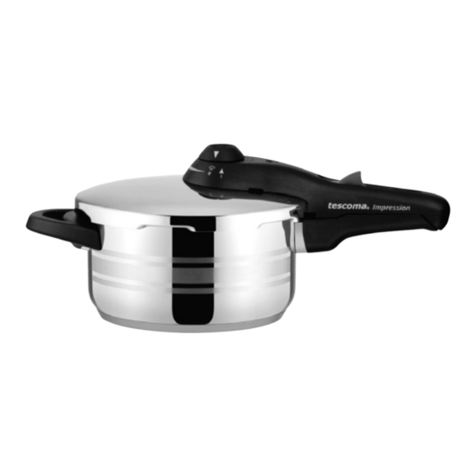
Tescoma
Tescoma IMPRESSION User manual
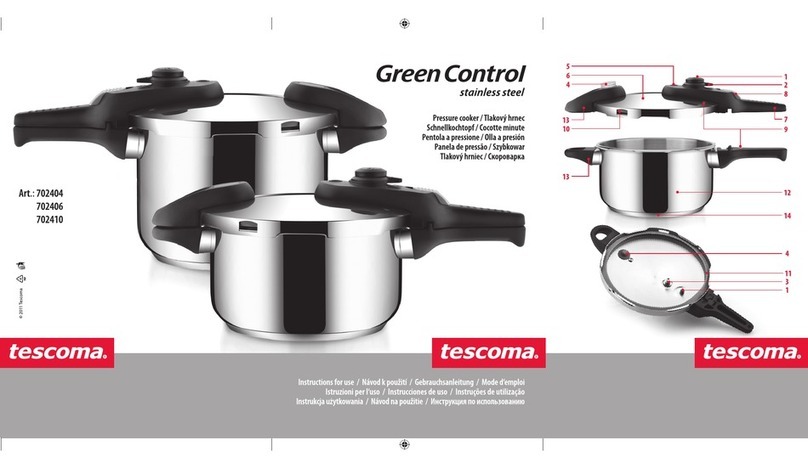
Tescoma
Tescoma 702404 User manual
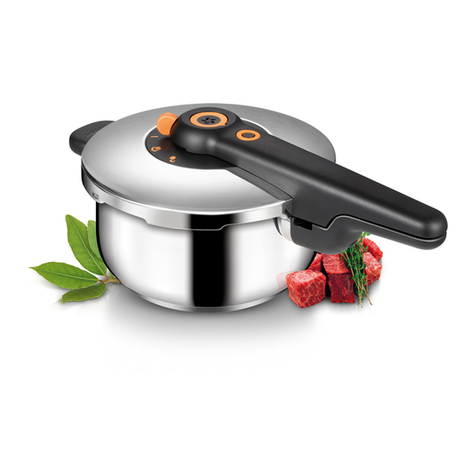
Tescoma
Tescoma SmartClick 702104 User manual
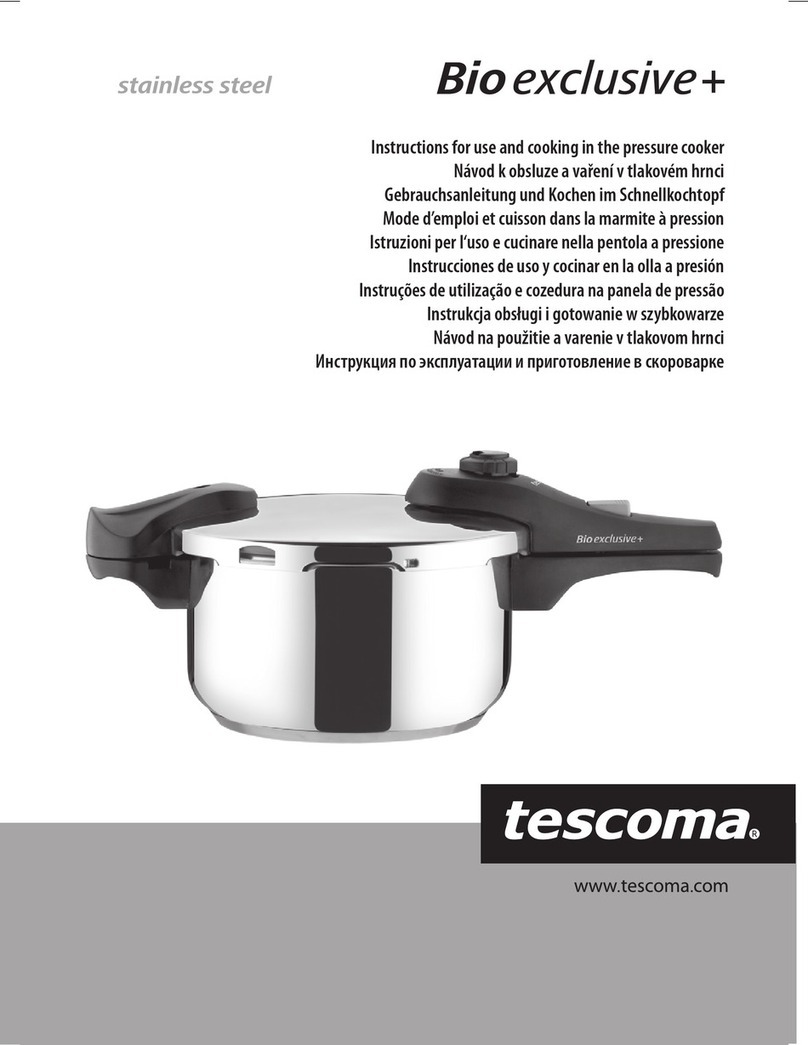
Tescoma
Tescoma Bio exclusice+ User manual
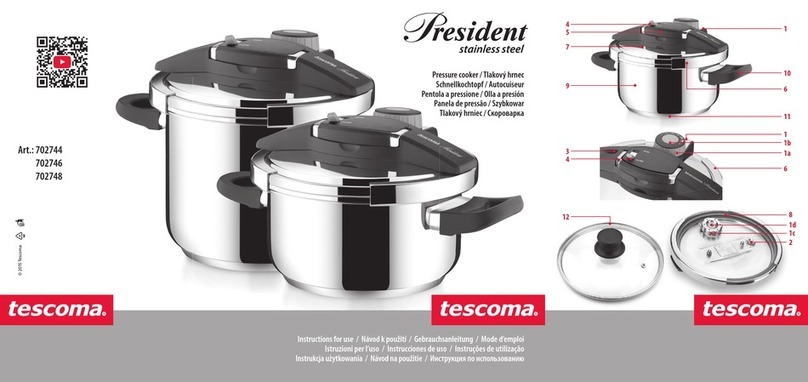
Tescoma
Tescoma President User manual
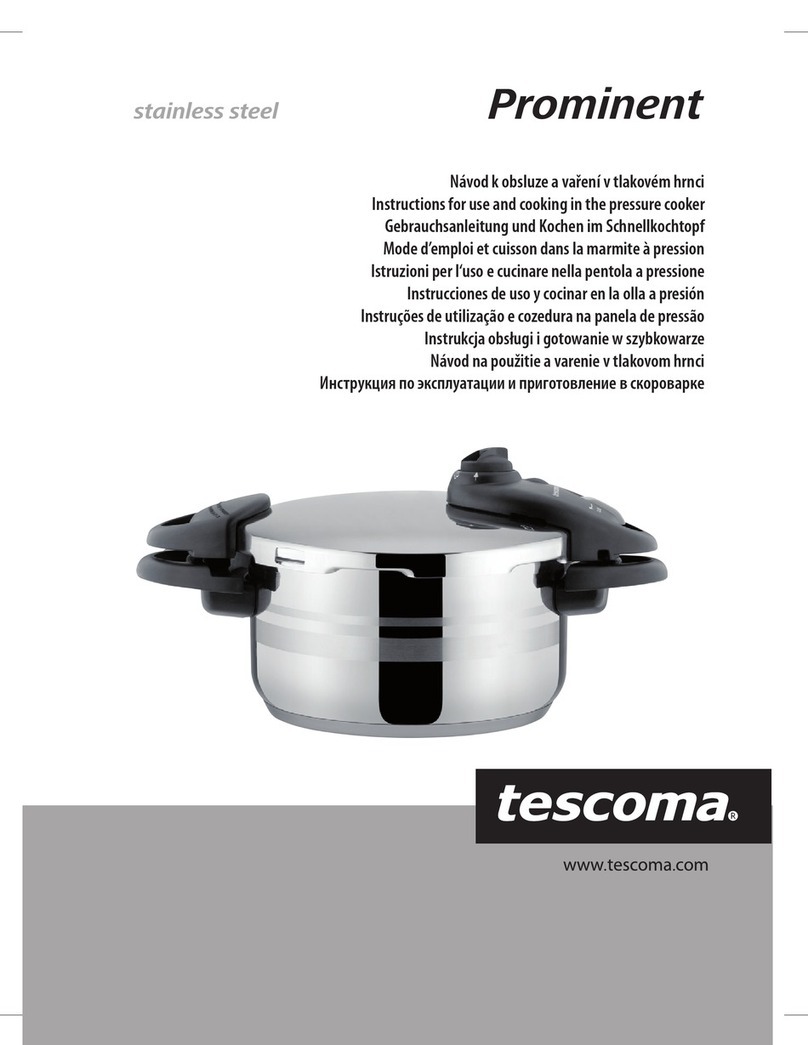
Tescoma
Tescoma Prominent User manual

Tescoma
Tescoma Ultima Series User manual
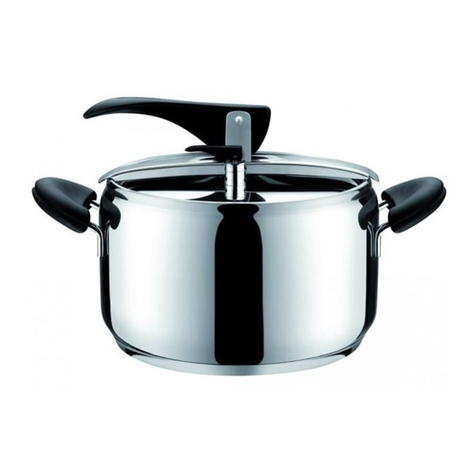
Tescoma
Tescoma MAGNUM User manual
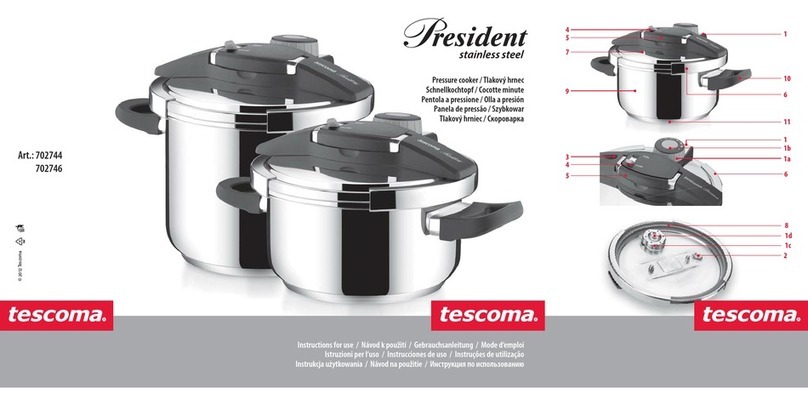
Tescoma
Tescoma President 702744 User manual
